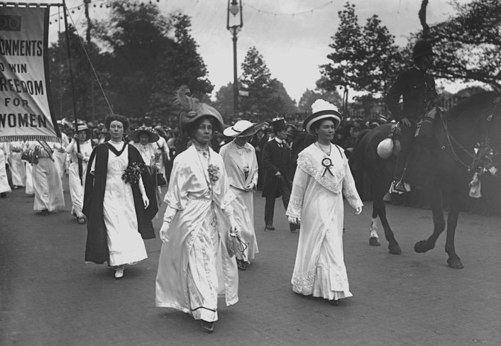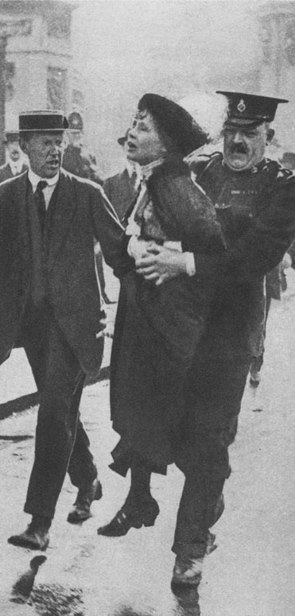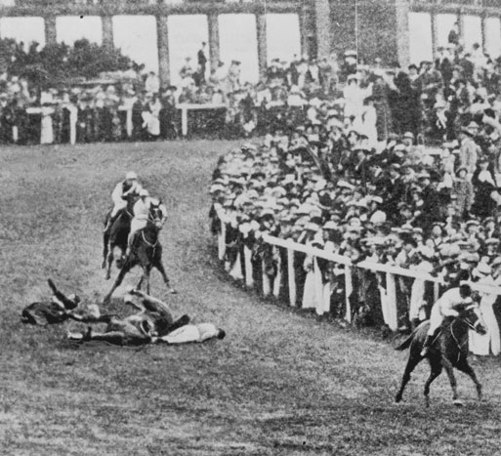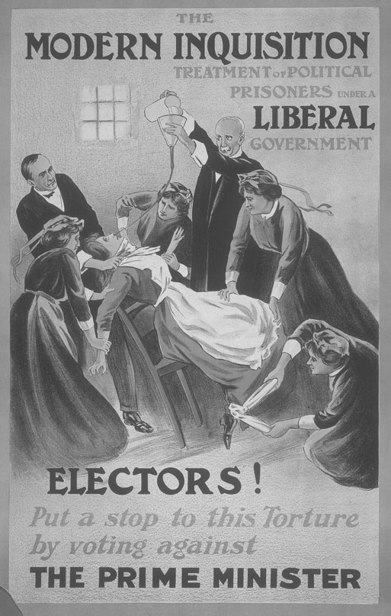Feminism (12 page)
Authors: Margaret Walters
Tags: #Social Science, #Feminism & Feminist Theory, #Anthropology, #Cultural, #History, #Social History, #Political Science, #Human Rights

76
Susan B. Anthony, who visited Manchester in 1902. Christabel wrote that, ‘it is unendurable to think of another generation of women wasting their lives for the vote. We must not lose any more time. We must act.’
The WSPU would remain, in essence, a family organization, though in 1906 it was Fred and Emmeline Pethick Lawrence who agreed to finance the cause, and found it headquarters in Clement’s Inn in London. (The WSPU is certainly the best-known, and was perhaps the most effective, group fighting for the vote, but there were many others – the Women’s Freedom League, the National Union of Women’s Suffrage Societies, the Actresses’ Franchise League – who may have been less high-profile, but did make progress.) From the start, Christabel Pankhurst dominated the WSPU, and soon a circle
Fightin
of devoted followers gathered around her. They included the former mill girl Annie Kenney, who was soon recognized as one of their
g for th
most effective speakers; a married woman and working-class Scot,
e v
Flora Drummond; and a socialist teacher, Teresa Billington.
ote: su
Less than a year later, the WSPU had something like 58 branches; it
ffra
had also suffered the first of what would prove numerous splits and
gett
revolts against Christabel. She was undoubtedly charismatic, and
es
inspired a sometimes unhealthy devotion among her many followers. But she was often dictatorial and ruthless, and so, perhaps to a lesser extent, was her mother Emmeline. Teresa Billington later remarked that Christabel exploited her followers; that ‘she took advantage of both their strengths and their weaknesses and laid on them the burden of unprepared action, refused to excuse weakness, boomed and boosted the novice into sham maturity, refused maturity a hearing’.
One woman, looking back in 1935, described Emmeline Pankhurst as ‘a forerunner of Lenin, Hitler and Mussolini – the leader whose fiat must go unquestioned, the leader who could do no wrong’.
There may well be truth in her angry exaggeration; and the same thing could be said, probably more accurately, of Christabel. She 77
was, Teresa Billington remarked, ‘a most astute statesman, a skilled politician, a self-dedicated re-shaper of the world, and a dictator without mercy’. Certainly, two of the WSPU’s most dedicated and effective organizers, Fred and Emmeline Pethick Lawrence, would be expelled from the organization in 1914, and even Sylvia Pankhurst was pushed out, in 1913. Sylvia was probably the most interesting, and certainly the most sympathetic, member of the family: a talented artist, and a socialist, who formed her own East London Federation (ELF) in an attempt to reach out to working-class women with families. She was the partner of the Labour politician Keir Hardie, who risked his own career by supporting votes for women.
The shift towards militant action was gradual. The suffragettes began by heckling politicians at public meetings; they moved on to organizing their own mass meetings and processions. From the start, they displayed a remarkable instinct for the propaganda effects of spectacle; they rapidly became adept at making their
minism
points visually and dramatically. There were mass marches through
Fe
the streets and demonstrations outside the Albert Hall, in Hyde Park: these public gatherings of women were, in Edwardian London, startling enough by themselves.
The suffragette colours were deployed effectively: the women dressed in white with green and purple sashes, and carried vividly colourful embroidered or appliquéd banners. The Artists’ Suffrage League created dramatically effective posters and postcards. One of the best known has two layers: on the top, with the label ‘What a Woman may be and yet not have the vote’, are the figures of a nurse, a mother, a doctor, and a factory hand; the lower layer, ‘What a man may have been and yet not lose the vote’, includes a convict, a lunatic, a white slaver, a drunkard, and (rather unfairly) a cripple described as ‘unfit for service’. Some of their propaganda was too sensational to be really effective: for example, a poster against the Cat and Mouse Act (relating to the release then re-arrest of hunger strikers from prison), which featured a vicious ginger cat, its teeth 78

6. Suffragette demonstration, led by the Pankhursts, 1911.
around the limp body of a woman dressed in the WSPU colours.
And some suffragettes, at least, seem to have been acutely aware of the possible political opportunities offered by that still comparatively new form, photography, and exploited it very effectively. Indeed, it is perhaps the photographic and visual record that they left behind them that makes the suffragettes still seem so immediately interesting. Old black and white photographs of marches and demonstrations make the period come to vivid life –
and so do images that capture what was seen as police persecution.
One famous photograph shows Mrs Pankhurst, looking small and fragile in her meticulously draped, formal clothes, being carried off by two angry and brutal-looking men.
It was only gradually that the suffragettes then turned to direct action. They began with what seem to have been mild physical confrontations: banging at politicians’ doors, or turning up en masse to protest at Downing Street. Feeling increasingly frustrated, they turned to sporadic acts of violence and arson: suffragettes
minism
began to set fire to letterboxes and smashed shop windows.
Fe
Emmeline Pankhurst once remarked that ‘the argument of the broken pane of glass is the most valuable argument in modern politics’. (Intriguingly, some of the West End shops whose windows were broken still advertised in the suffragette paper; some offered clothes in WSPU colours, and one even sold underwear in white, purple and green.)
According to Sylvia Pankhurst, who apparently approved, ‘three Scottish castles were destroyed by fire in on a single night’. In early 1914, the Carnegie Library was burnt down, as well as two ancient churches and many large empty houses. Mary Richardson slashed Velázquez’s painting of the Rokeby Venus in the National Gallery, announcing that ‘I have tried to destroy the picture of the most beautiful woman in mythological history because the Government are destroying Mrs. Pankhurst – the most beautiful character in modern history’. Some militants went even further; they set fire to the house of a minister who was hostile to the cause, and two 80

7. Emmeline Pankhurst was arrested outside Buckingham Palace in
May 1914, after trying to present a petition to the King. The man on the
left looks frighteningly angry; the uniformed policeman is perhaps just
doing his job.
81

women actually tried to burn down a crowded theatre in Dublin.
And one woman, Emily Wilding Davison, died for the vote. Having declared that ‘a tragedy was wanted’ for the cause, on Derby Day 1913, she rushed onto the course in the middle of the race –
certainly risking, or even inviting, death – and brought down the King’s horse. She died of her injuries a few days later. But although, initially, the militants, and even fanatics like Davison, had aroused real sympathy, they were also managing to alienate many supporters.
Not everyone, even within the movement, agreed with the new, and escalating, tactics, which meant that increasing numbers of women were going to prison. Teresa Billington, who had formerly worked closely with Emmeline Pankhurst, denounced the adoption of
minism
Fe
8. Emily Davison sacrifices herself for the cause, and dies after
throwing herself under the King’s horse on Derby Day 1913.
82
violence, which would ‘condemn a large number of women to personal sacrifice that in some cases amounts to suicide, and in all cases to the suffering of terrible strain and much possible abuse’.
She argued that militancy was thereby ‘degraded from revolution into political chicanery’, and denounced the ‘pose of martyrdom’
and the way suffragettes were presenting themselves ‘not as rebels but as innocent victims’. Elizabeth Garrett Anderson resigned from the WSPU, and even Adela Pankhurst argued against extreme militancy. Divisions within the movement therefore increased.
As early as 1908, suffragettes who had been imprisoned for some form of direct or violent action had begun protesting against the authorities by going on hunger strikes. The first few women were released, but as more joined in, the authorities began to force-feed
Fightin
them. Many saw themselves, and were seen by many others, as martyrs. Emmeline Pankhurst went to gaol several times, and so did
g for th
the Pethick Lawrences. Lady Constance Lytton had first been
e v
gaoled in 1909, but realizing that her rank had ensured her better
ot
treatment, when she was released she disguised herself, was
e: su
sentenced again, and force-fed eight times. Her health was
ffr
a
permanently damaged. The passage of the Prisoners’ Temporary
gett
Discharge Bill, popularly know as the Cat and Mouse Act, aroused
es
great controversy: women were released from prison until they recovered their health, at which point they were re-arrested. They aroused wide and genuine sympathy, but, as time went on, there was increasing criticism of their campaign, even from former supporters. Teresa Billington, for example, decided: ‘I do not believe that the best avenue for the emancipation of women is through emotionalism, personal tyranny and fanaticism.’
By this stage, Christabel Pankhurst had long retreated from the fight. She was in Paris, where she led a life of ease and even luxury, avoiding the increasing perplexities faced by suffragettes at home.
‘Ladies!’ she had proclaimed in 1910, ‘The truce was all very well, but there is nothing like militancy. We glory in this fight because we feel how much it strengthens us.’ The devoted Annie Kenney visited 83

9. Poster dramatizing the condition of the suffragette prisoners being
force-fed, 1910.
84
her every weekend, bringing back instructions from the leader in exile; other, more clear-sighted women were, very justly, critical of her absence.
